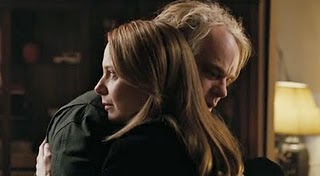Interview: Amy Ryan of ‘Jack Goes Boating’
Posted on September 27, 2010 at 11:10 am
 Amy Ryan gave my favorite performance of 2007 as the mother of a missing girl in “Gone Baby Gone.” And it has been a pleasure to see her since then in roles as varied as Holly the human resources manager and love interest for Steve Carell in “The Office” and a journalist stationed in Iraq opposite Matt Damon in “The Green Zone.” She is now appearing in “Jack Goes Boating,” the first film directed by Philip Seymour Hoffman, who also appears in the title role. Ryan plays Connie in this story of two loners who try to reach out to one another. I spoke to her about this film and about her just-announced return to “The Office” for several episodes of Carell’s last season.
Amy Ryan gave my favorite performance of 2007 as the mother of a missing girl in “Gone Baby Gone.” And it has been a pleasure to see her since then in roles as varied as Holly the human resources manager and love interest for Steve Carell in “The Office” and a journalist stationed in Iraq opposite Matt Damon in “The Green Zone.” She is now appearing in “Jack Goes Boating,” the first film directed by Philip Seymour Hoffman, who also appears in the title role. Ryan plays Connie in this story of two loners who try to reach out to one another. I spoke to her about this film and about her just-announced return to “The Office” for several episodes of Carell’s last season.
You came into a movie with three performers who had played those characters together on stage. Was that a challenge?
The challenge would have been bigger if I had joined them in the stage production. In this case there was about two years from the stage play to the screenplay and Bob Glaudini, the writer reworked some of the scenes and the characters. So they were re-discovering it while I was discovering it. We had a two-week rehearsal process in a room with our DP and script supervisor where we set out on it together.
You’ve now worked with a couple of actors turned directors, Ben Affleck with “Gone Baby Gone” and now Philip Seymour Hoffman, who was your director and co-star. What does an actor know that helps him as a director?
Two things that come to mind. One is truly a shared language. The bigger thing is compassion for knowing what’s it like to go to certain very dark or vulnerable places. Although I’ve had great support from non-acting directors, there’s just a shared experience. Phil never asked us to go places that he wasn’t going to himself. He had to be very vulnerable, especially those love scenes. He’s say, “You need to go there but don’t worry, I’m going to be right behind you — or I’m leading the way.”
This movie respects its audience enough that it doesn’t feel it has to give us explicit explanations for the characters’ behavior by telling us about their past. But do you need to create that for yourself in developing your performance?
Absolutely. Discussions with Bob and with Phil. I flat-out asked Bob: “What’s her story? Why does she use this language? Why is she so shy but why is she so vocal about what she wants, romantically and sexually?” He just kind of shrugged his shoulders. He really let me find it, which was at times frustrating. I wanted the answers. I knew they knew. But it was very generous in saying, “It’s okay for you to make it your own.” It’s easy to jump to the conclusion that something terrible happened to Connie. We don’t see characters like her in a love story very often. She’s in her 40’s and not good at love. She doesn’t have confidence in her workplace. She’s alone in New York City, and that’s enough. She’s an awkward person. Getting out of situations is never going to be a smooth thing.
She says very clearly, “Don’t hurt me.” She thinks too much. She says to herself, “This doesn’t feel good yet, but I’m going to keep trying. I wanted it to be like this, I wanted it to be like that, but I’m going to let go of what I imagined. But now I’m here with you. So overcome me.”
I was delighted to hear that you’re returning to “The Office!”
Me, too! It’s good fun. That whole group, as you can imagine, truly is a barrel of laughs. I love working with Steve Carell. He is so generous. He never sets the tone of “Keep up with me or out of my way.” He really just says, “Come with me.” He is really, really fun.


